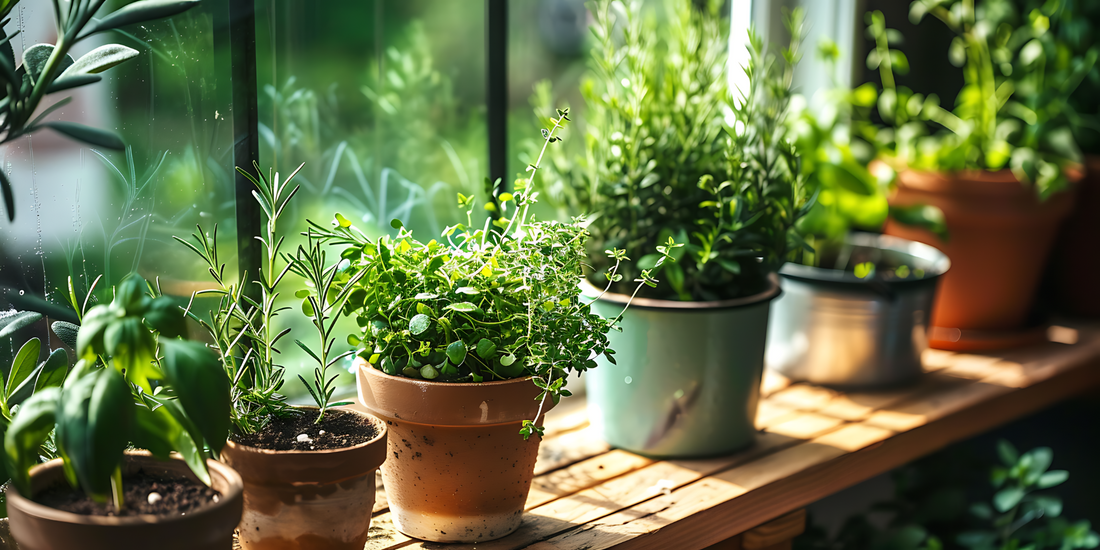
Your Guide to a Flavorful Kitchen Garden
Hello, aspiring herb gardeners! Ever dreamt of adding a pinch of fresh herbs to your cooking without needing to dash to the store? You're in luck! Growing herbs indoors is not only easy but also incredibly rewarding. Imagine having a lush, green garden right in your kitchen, ready to add flavor to your culinary creations. Let's dive into the delightful world of indoor herb gardening, where even the busiest city dwellers can grow fresh, flavorful herbs.
Herb Garden 101: Meet the Flavor Squad
-
Basil Basil is the rock star of the herb world. Whether it's in a pesto, sprinkled on pizza, or mixed into a fresh salad, basil is a must-have. It loves sunlight and warm temperatures, so place it on a sunny windowsill and watch it thrive. Just keep it hydrated—basil likes to be watered regularly.
-
Mint Mint is the overachiever in the herb family. It grows vigorously and can take over your garden if you’re not careful. Indoors, it’s best kept in its own pot. Mint is perfect for teas, cocktails, and even savory dishes. It prefers indirect light and slightly moist soil.
-
Rosemary Rosemary is the sturdy, reliable herb that brings a burst of flavor to roasts and soups. It thrives in a sunny spot and doesn’t need much water, making it perfect for those who might forget their plants occasionally. Plus, it smells divine!
-
Thyme Thyme is the understated hero of the herb garden. It's low-maintenance and packs a punch in the flavor department. Ideal for soups, stews, and roasted vegetables, thyme loves a sunny spot and well-drained soil. It’s drought-tolerant, so you can water it less frequently.
-
Cilantro Cilantro, also known as coriander, is a controversial herb—people either love it or hate it. For cilantro lovers, this herb is a staple for salsas, guacamole, and many Asian dishes. It grows best in cooler temperatures and prefers bright, indirect light.
-
Parsley Parsley is more than just a garnish. It’s a powerhouse of flavor and nutrients, perfect for adding to almost any dish. It prefers bright, indirect light and slightly moist soil. Harvest regularly to encourage new growth and prevent it from bolting.
-
Oregano Oregano is the go-to herb for Italian and Greek cuisine. It’s a hardy plant that thrives in sunlight and well-drained soil. Oregano’s robust flavor makes it a great addition to pizzas, pastas, and meat dishes. Give it a sunny windowsill, and it will reward you with plentiful leaves.
-
Chives Chives are the versatile, mild onion-flavored herb that’s perfect for sprinkling on baked potatoes, salads, and soups. They prefer bright light and well-drained soil. Chives are perennial, so they’ll keep coming back year after year, even in a pot.
-
Sage Sage is the earthy, robust herb that adds depth to stuffing, sausages, and roasted meats. It thrives in sunny conditions and well-drained soil. Once established, sage is quite drought-tolerant and easy to care for.
-
Dill Dill is the feathery, fragrant herb that's perfect for pickles, fish dishes, and creamy sauces. It prefers a sunny spot and slightly moist soil. Dill can grow quite tall, so give it some space to spread out.
Starting Your Indoor Herb Garden: The Basics
-
Choose the Right Location: Most herbs need plenty of light. A sunny windowsill that gets at least 6 hours of sunlight a day is ideal. If you lack sufficient natural light, consider using a grow light to supplement.
-
Select Your Containers: Use pots with drainage holes to prevent waterlogging. Herbs don’t like to sit in water, and proper drainage will keep them healthy. Small pots are fine to start with, but you may need to upgrade as your plants grow.
-
Prepare the Soil: Use a well-draining potting mix designed for herbs or vegetables. Regular potting soil can work, but adding some sand or perlite can improve drainage.
-
Planting: You can start herbs from seeds or buy young plants from a nursery. Follow the planting depth recommendations on seed packets or plant tags. Don’t overcrowd the pots; give each herb room to grow.
-
Water Wisely: Most herbs prefer their soil to dry out slightly between waterings. Water thoroughly when the top inch of soil feels dry. Avoid overwatering, which can lead to root rot.
-
Harvest Regularly: Regular harvesting encourages bushier growth and prevents herbs from flowering too soon. Snip just above a leaf node to promote new shoots.
-
Feed Occasionally: Herbs don’t need a lot of fertilization, but a light feeding with a balanced fertilizer once a month can help keep them vigorous and productive.
Troubleshooting: When Your Herbs Need Some TLC
- Yellow Leaves: This can be a sign of overwatering. Check your watering habits and ensure proper drainage.
- Leggy Growth: Not enough light. Move your herbs to a sunnier spot or provide supplemental lighting.
- Pests: Herbs can attract pests like aphids and spider mites. Use insecticidal soap or neem oil to treat infestations.
And there you have it—a foolproof guide to starting your indoor herb garden! With these easy steps and a little bit of love, you’ll soon have a thriving garden of fresh herbs ready to take your cooking to the next level. Happy gardening!
